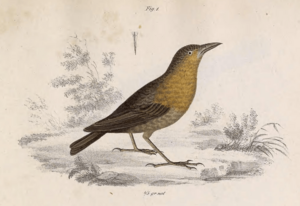Chestnut-breasted wren facts for kids
Quick facts for kids Chestnut-breasted wren |
|
|---|---|
 |
|
| Conservation status | |
| Scientific classification | |
| Genus: |
Cyphorhinus
|
| Species: |
thoracicus
|
 |
|
| Synonyms | |
|
Leucolepis thoracicus |
|
The chestnut-breasted wren (Cyphorhinus thoracicus) is a small, active bird that belongs to the wren family. It's known for its beautiful songs and its shy nature. You can find this bird living in the forests of Colombia, Ecuador, Peru, and Bolivia in South America.
Contents
About the Chestnut-breasted Wren
How Scientists Classify This Bird
Scientists like to group animals to understand them better. For the chestnut-breasted wren, most bird experts agree there are two main types, called subspecies. These are Cyphorhinus thoracicus thoracicus (the "southern" type) and C. t. dichrous (the "northern" type). Some groups, like BirdLife International, even think these two types are different species entirely!
What Does It Look Like?
This wren is a small bird, usually about 11 to 15 centimeters (4.5 to 6 inches) long. It weighs around 26 to 41 grams (less than 2 ounces), which is about the weight of a few quarters.
Both the northern and southern types look very similar. They have a dark, sooty black or very dark brown head. Their back and rump are a rich dark brown, and their tail is also dark brown.
One of their most striking features is their face, throat, and upper belly, which are a deep orange-brown color. Their sides and lower belly are dark brown. Young wrens look much like the adults, but their lower belly might be a bit lighter in color.
Where Does It Live?
The "northern" subspecies, C. t. dichrous, lives in the Andes mountains of Colombia and Ecuador, stretching down into northern Peru. The "southern" subspecies, C. t. thoracicus, is found further south in central Peru and western Bolivia.
These wrens love wet montane forests, especially cloud forests. These forests are often misty and have lots of epiphytes (plants that grow on other plants, like mosses and ferns) and moss covering the trees.
You'll usually find the northern type living at elevations between 1,100 and 2,600 meters (about 3,600 to 8,500 feet) above sea level. The southern type lives a bit higher, mostly between 1,200 and 2,700 meters (about 3,900 to 8,900 feet).
How the Wren Behaves
What Does It Eat?
The chestnut-breasted wren spends most of its time close to the ground, usually within 1 meter (about 3 feet) of it. It searches through fallen leaves and other plant material on the forest floor. It mainly eats small creatures without backbones, like beetles and spiders.
These wrens usually hunt for food alone or in pairs. Sometimes, you might see them in small family groups. They don't often join larger groups of different bird species that are foraging together.
How Does It Raise Its Young?
Scientists don't know a lot about the breeding habits of the chestnut-breasted wren. It seems they can lay eggs at different times of the year, depending on the region.
One nest found in Peru was shaped like a dome and was made mostly of fresh plant material. It was built very close to the ground and contained two eggs.
What Does Its Song Sound Like?
The songs of the two subspecies are quite different!
- The "southern" C. t. thoracicus sings a varied and musical song. It's usually a slow series of clear, flute-like whistles that change in pitch. After these, it might sing a faster series of 5 to 11 short whistles or a very fast, trilled sound. Its call sounds a bit like a low, frog-like "krol."
- The "northern" C. t. dichrous sings a series of usually 3 to 4 clear, almost magical-sounding whistled notes. Its call is a harsh "churr" sound.
Is the Wren in Danger?
The IUCN (International Union for Conservation of Nature) looks at the two subspecies separately. Both are listed as "Least Concern," which means they are not currently in danger of disappearing.
The chestnut-breasted wren is quite common in some parts of Colombia. However, it's less common in Ecuador and can be rare to uncommon in Bolivia. In Peru, it's uncommon in some places but common in others. Luckily, these birds live in several protected areas, which helps keep their populations safe.
See also
 In Spanish: Cucarachero pechicastaño para niños
In Spanish: Cucarachero pechicastaño para niños


